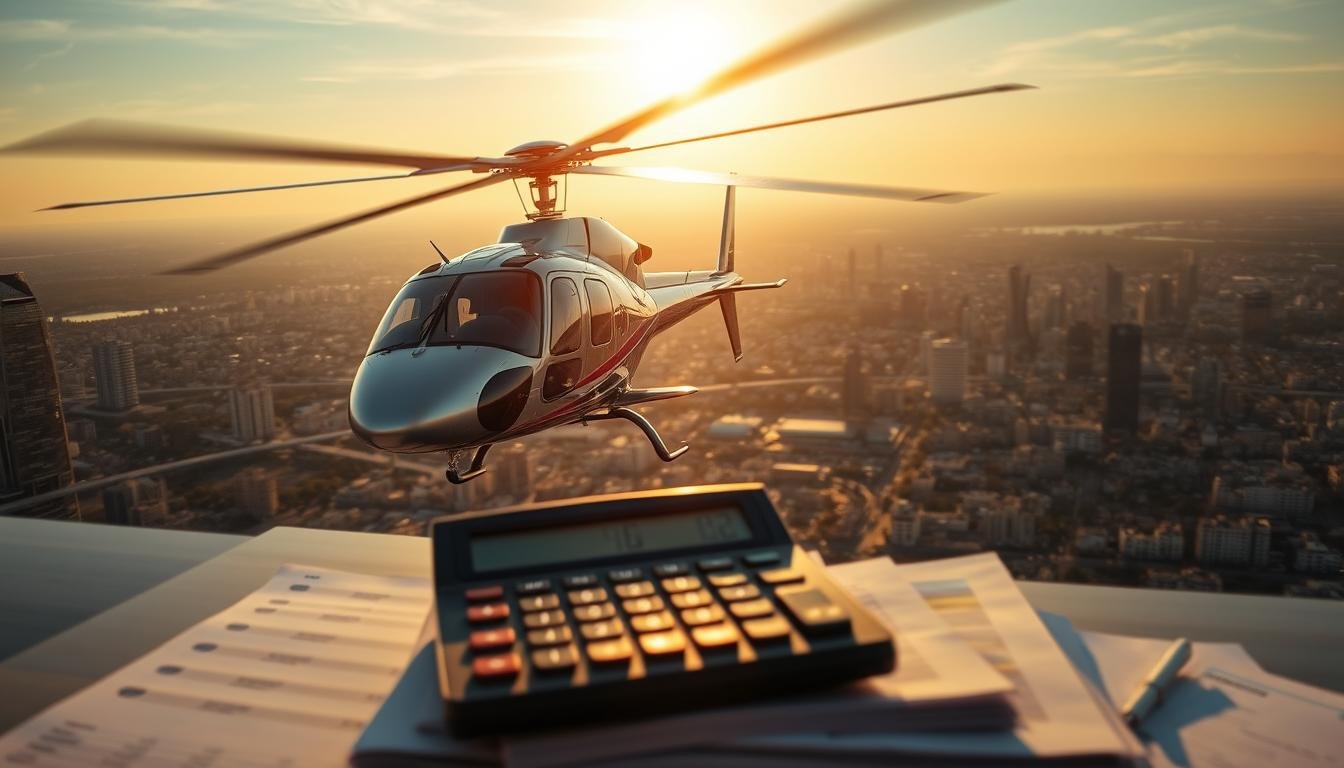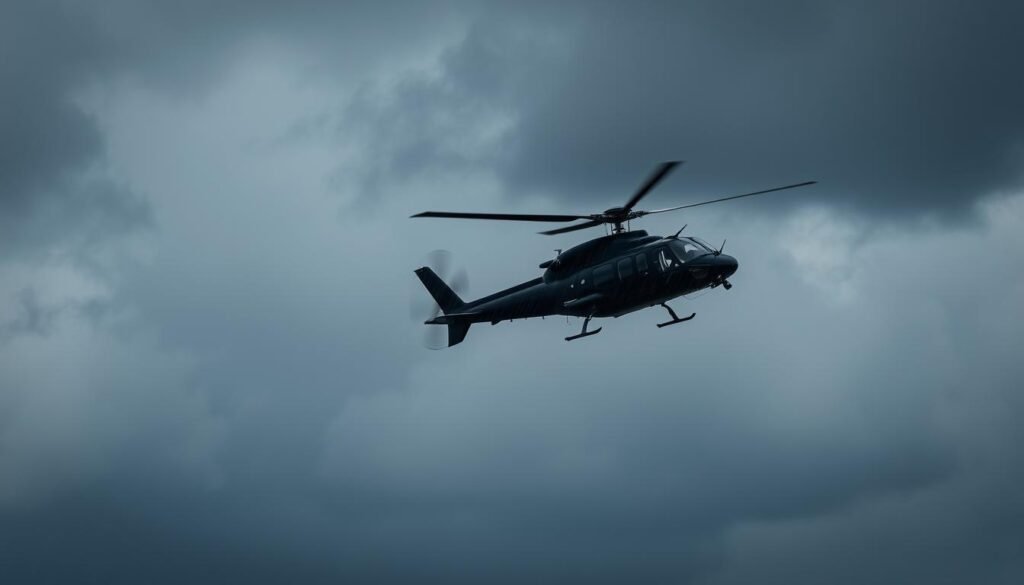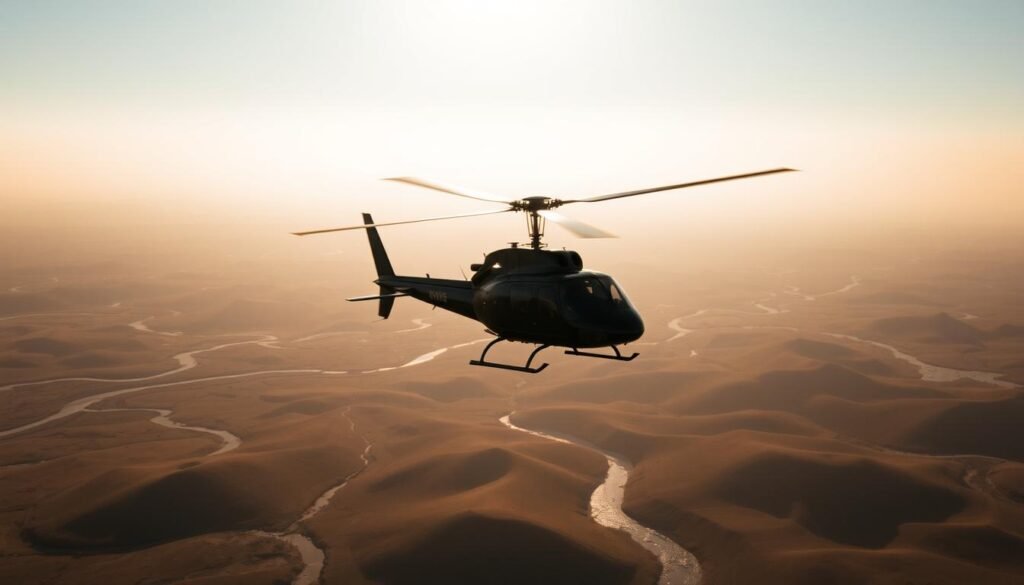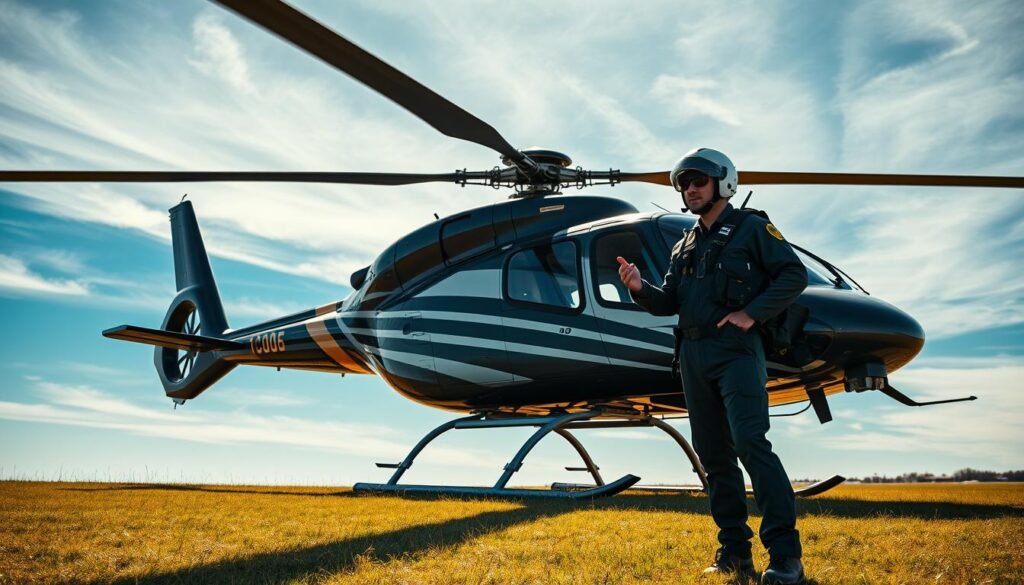Surprising fact: an example training rotorcraft can run about $560.80 per flight hour before downtime or surprise repairs, based on reported monthly lease, insurance, and operating totals.
This introduction lays out a clear method for turning big annual numbers into per-hour figures. It contrasts sticker prices with the full stack of expenses that owners and operators face in the U.S. aviation industry.
Readers will see concrete examples: monthly lease fees, annual insurance, fuel, maintenance reserves, hangar fees, and pilot pay — all summed, then divided by realistic annual flight hours.
The piece signals why published hourly rates vary and previews model-specific ranges, from small training craft to large multi-engine ships. It also links practical guidance with a detailed rental and hourly breakdown for deeper reading via rental and hourly breakdown.
Key Takeaways
- Real per-hour figures come from annualizing all fixed and variable expenses.
- Lease, insurance, and maintenance often drive the biggest monthly totals.
- Flight hours are the main lever: more utilization lowers per-hour price.
- Published rates differ because of assumptions about downtime and reserves.
- Compare model-specific examples to match mission profile and budget.
Myths vs. Reality: What Drives Helicopter Flight Costs
Many sticker rates hide the fixed bills that keep rotary operations flying each month.
Visible hourly prices often omit the steady monthly burden of lease or financing. For example, a $5,200 monthly lease plus roughly $2,250 in monthly insurance and routine fuel and maintenance can total about $11,216 per month. With 20 flight hours that converts to a raw $560.80 per hour, before downtime and contingencies.
That arithmetic explains why published rates look high: they are a direct expression of monthly outlays divided by realistic utilization.
Why Helicopter Hourly Rates Seem So High
Liability often runs $2,800–$4,000 yearly; adding hull coverage can raise premiums by $15,000–$20,000. Safety and mandated inspections create predictable, recurring bills. Experienced pilots require pay and recurrent training, which raises operating overhead.
Common Misconceptions About Profit Margins And “Overpricing”
Readers who see only the hourly figure miss reserves for unexpected repairs and scheduling gaps. The industry is recovering costs, not padding invoices.
| Category | Monthly | Impact Per 20 Flight Hours |
|---|---|---|
| Lease/Financing | $5,200 | $260.00/hr |
| Insurance (liability + hull) | $2,250 | $112.50/hr |
| Fuel, Maintenance, Others | $3,766 | $188.30/hr |
| Total | $11,216 | $560.80/hr |
The Real Cost Stack: Fixed And Variable Expenses That Add Up
Owners and operators must stack dozens of line items before any hourly figure feels realistic. This section breaks fixed obligations and variable spends into clear pieces so readers can see the full picture.
Fixed Costs: Lease Or Financing, Insurance, And Hangar/Tie-Down Fees
Lease or financing often sets the monthly floor — a $5,200 payment alone shapes budget planning. Annual insurance can run near $26,000 for training operations, while hangar or tie-down fees vary by airport and amenities.
Insurance Reality Check: Liability And Hull Policies In The United States
Liability usually ranges $2,800–$4,000 per year. Hull coverage can add $15,000–$20,000 depending on aircraft value and mission profile.
Fuel And Oil; Maintenance And Inspections
Fuel budgeting pairs burn rates with regional price swings. For example, a Bell 206 burns ~26–30 gal/hr; at $6.97/gal Jet‑A that is roughly $181–$209 per flight hour. Oil and routine service add small per-hour increments.
Operating Add-Ons And Putting It Together
Landing, parking, compliance items, and pilot pay round out monthly spend. The standard method totals monthly and annual figures, converts to a year, then divides by realistic annual hours to reach an hourly rate.
- Fixed bills set a cash floor.
- Fuel and maintenance scale with use.
- Annualize every item, then divide by planned hours for a defensible per-hour number.
How Much Does It Cost To Fly A Helicopter Per Hour?
Comparing specific models clarifies why one aircraft can cost many times more per flight hour than another.
Real‑world examples span from light piston trainers up to heavy turbine workhorses. The Robinson R22 posts the lowest direct operating numbers at roughly $164 per hour, while an Airbus H155 reaches about $1,593 per hour. The R44 sits between those extremes and often represents the middle ground for training and light charter.
Real-World Examples: Robinson R22, Robinson R44, And Airbus H155
Small piston craft offer low fuel burn and simpler maintenance, but lower payload and speed. Turbine, multi‑engine aircraft demand higher fuel, component lifing, and insurance reserves, which drives rates up.
Case Study Math: $5,200 Lease, ~$26,000/Year Insurance, Fuel, And Maintenance
Using the training operator’s monthly basket—$5,200 lease, about $2,250 monthly insurance, roughly $1,200 fuel for 20 hours, plus inspections and maintenance—this totals $11,216 per month. Dividing by 20 hours produced ~$560.80 per hour before downtime and surprises.
| Aircraft | Typical Direct Cost | Fuel Burn (gal/hr) | Notes |
|---|---|---|---|
| Robinson R22 | $164/hr | 6–8 | Lowest operating prices; good for training |
| Robinson R44 | $420–$600/hr | 12–16 | Mid‑range performance and costs |
| Airbus H155 | $1,593/hr | 25+ | High fuel and maintenance; multi‑engine mission work |
Takeaway: Aircraft selection, realistic hours planning, and hourly reserves for inspections and insurance determine final rates. If utilization falls below plan, the per hour figure rises; higher hours dilute fixed bills and improve economics.
Ownership, Charter, Or Training: Choosing The Right Path For Your Budget
Deciding between purchase, rental, or lessons starts with clear use estimates and honest math. Each route shifts who pays for maintenance, insurance, and storage. The right path depends on hours flown per year and mission needs.
Owning A Helicopter: Purchase Price, Financing, And Monthly Outlay
Ownership gives full availability but concentrates fixed expenses. A new Robinson R22 may list near $300,000; used examples can be near $100,000. An Airbus H155 can exceed $15 million new and around $8 million used.
Financing converts that sticker into monthly payments. Owners must add insurance (liability ~$2,800–$4,000; hull +$15k–$20k yearly), hangar, and routine reserves.
Charter And Tours: Typical Hourly Rates For Small Vs. Larger Aircraft
Charter shifts maintenance and insurance risk to the operator. Small two-seat flights often run about $300 per hour with a pilot. Larger multi-passenger aircraft cost significantly more due to fuel and crew needs.
Flight Schools And Lessons: Intro Flights And Training Hour Prices
Flight schools offer structured training and intro lessons. Training rates commonly average near $200 per hour depending on location and aircraft. Piston trainers lower per hour compared with turbine platforms.
Value Considerations: Usage, Flexibility, And Total Cost Of Time Saved
Model expected annual hours and compare ownership per hour versus market charter or school rental. Consider door-to-door time saved, scheduling flexibility, and mission access.

| Option | Typical Upfront | Typical Per Hour |
|---|---|---|
| Ownership | $100k–$15M+ | Varies by hours; fixed costs dilute with use |
| Charter | None | Small ~ $300/hr; larger = higher |
| Flight School | Intro lesson fees | Training ~$200/hr |
For readers building pilot hours or comparing long-term value, a detailed cost review helps. See a focused training cost comparison at pilot training costs.
Budgeting For Helicopter Flight: Location, Experience, And Usage Patterns
Budget planning must account for local charges, crew wages, and seasonal fuel swings that change per‑hour math.
Location shapes nearly every line item. Hangar rents, landing fees, and local taxes vary by airport and region. Fuel and service prices can shift direct operating numbers quickly.

Location Matters: Airport Fees, Fuel Prices, And Pilot Pay Rates
Pilot pay ranges widely — roughly $50,000 in lower‑cost markets up to $180,000 in places like New York, with averages near $100,000.
Regional Jet‑A and 100LL prices also differ. Planning routes and fuel stops can lower annual spend and improve value per hour flown.
Pilot Experience And Insurance Requirements: How They Affect Costs
Pilot experience influences safety and underwriting. Insurers often require minimum hours, type time, or recurrent training before offering favorable terms.
Less experienced crews can raise premiums and operational limits. Operators should model conservative annual hours and include buffers for downtime.
| Factor | Typical Range | Budget Impact |
|---|---|---|
| Pilot Annual Pay | $50k – $180k | Largest recurring labor cost |
| Fuel Price Variation | Regional ±20% | Direct hourly swing |
| Airport Fees & Hangar | Low – High (market) | Affects fixed monthly floor |
| Insurance Requirements | Experience + Usage | Premiums vary by operator risk |
- Geography affects landing, parking, and hangar fees.
- Local labor markets set pilot wages and benefits.
- Usage patterns change per‑hour economics; steady hours lower unit costs.
- Review assumptions annually and use tools like an operating cost guide or training cost breakdown for planning: operating cost guide, training cost breakdown.
Final Thoughts
When operators build a disciplined annual model, scattered bills and seasonal swings become a clear per hour number.
Smaller craft like the Robinson R22 show direct operating rates near $164 per hour while large types such as the Airbus H155 can top $1,500. A sample operator budget—$11,216 monthly driven by lease, roughly $26,000 yearly insurance, maintenance, hangar and fuel—converted to about $560.80 per hour at 20 hours a month.
Practical action: list financing, insurance, hangar, landing, maintenance, fuel, and pilot pay, then divide by real annual hours. Revisit the model each year and invest in training and ground planning to protect utilization and safety.
For a rental overview and practical next steps see rental overview.
FAQ
What are typical hourly rates for training aircraft like the Robinson R22 and R44?
Training aircraft such as the Robinson R22 often rent for about $200–$300 per hour wet, while the Robinson R44 commonly ranges from $350–$500 per hour wet. Rates vary by flight school, region, and instructor fees. Local fuel prices, maintenance schedules, and insurance requirements influence final pricing.
Why do hourly rates for rotorcraft appear higher than those for fixed-wing planes?
Helicopters require specialized maintenance, more frequent inspections, and parts that often cost more. They burn turbine or avgas at higher rates, need trained mechanics, and have higher insurance premiums. These fixed and variable expenses spread over fewer flight hours drive up the hourly operating rate.
What fixed costs contribute to annual operating budgets?
Fixed costs include lease or loan payments, hangar or tie-down fees, annual insurance premiums, and regulatory compliance expenses. These line items persist regardless of flight time and must be amortized across total hours flown to determine per-hour expense.
How does insurance affect operating budgets in the United States?
Liability and hull coverage premiums depend on aircraft value, pilot experience, intended use, and location. For many owners, annual premiums range from several thousand dollars for small trainers to tens of thousands for turbine helicopters. Insurers also factor in pilot records and flight hours.
What role does fuel play in price variability?
Burn rates differ widely: a piston R22 uses roughly 8–10 gallons per hour, a piston R44 about 20 gallons per hour, while turbine types burn much more. Regional avgas or Jet A prices fluctuate, so fuel can be a major line-item that changes monthly and by airport.
How often are maintenance checks required and how costly are they?
Maintenance includes routine inspections, oil changes, 100-hour or annual checks, and component overhauls with varying intervals. Costs depend on aircraft type; small piston models have lower parts costs but mechanical labor still adds up. Downtime for inspections also reduces billable hours.
What additional operating fees should operators expect?
Operators may face landing and parking fees, navigation charges, pilot salaries for charter flights, and costs for compliance items such as ADS-B or avionics upgrades. These add-ons can be applied per flight or bundled into hourly rates by operators.
How are annual expenses converted to an hourly operating rate?
Operators sum fixed and variable annual expenses, add desired profit or reserve margins, then divide by projected annual flight hours. Lower utilization raises the per-hour figure, while higher utilization spreads fixed costs more thinly and reduces the hourly rate.
Can a sample budget illustrate the math for a leased helicopter?
A sample scenario might include a $5,200 monthly lease, roughly $26,000 yearly insurance, fuel and maintenance estimates, and pilot or hangar fees. Summing those annual expenses and dividing by expected annual hours yields an hourly target rate operators use for charter pricing or ownership decisions.
What are typical price ranges for charter flights using small versus larger helicopters?
Small piston charters and tours commonly start near $350–$650 per hour. Turbine and larger multi-passenger aircraft often range from $1,000 to several thousand dollars per hour depending on model, payload, and service level.
How much do introductory flights and lessons at flight schools usually run?
Introductory discovery flights with an instructor typically cost from $150 up to $400 depending on aircraft and region. Per-hour lesson rates for student pilots vary by school and trainer type, often aligning with R22 or R44 rental rates plus instructor time.
What ownership factors change total cost of ownership?
Purchase price, financing terms, expected utilization, maintenance reserves, hangar availability, and resale expectations shape ownership economics. Owners who fly frequently may see lower per-hour costs than renters, but they also shoulder risk for unexpected repairs and storage.
How do location and airport choice influence overall expenses?
Major metro airports often levy higher landing, tie-down, and fuel costs. Rural or private airfields may offer lower fees but can add ferry time. Fuel availability and regional labor rates for pilots and mechanics further affect operating budgets.
In what ways does pilot experience impact insurance and operating costs?
Insurers typically offer better rates for pilots with higher totals of make-and-model hours, formal checkouts, and low incident records. Operators may require minimum experience levels for certain missions, influencing staffing costs and charter pricing.
Related Articles
- Can Anyone Learn to Fly a Helicopter? Understanding Training and Skills Required
- Why Do Helicopters Make That Distinctive Sound? Helicopter Noise Explained
- Do Helicopters Require More Maintenance Than Airplanes? Separating Fact from Fiction
- How Far Can Helicopters Travel? Dispelling Range Myths
- What Happens if a Helicopter Engine Fails? Debunking Catastrophe Myths
More from This Category
- Are Helicopters More Dangerous Than Planes? A Safety Comparison
- Do Helicopters Have Parachutes? Exploring Emergency Systems
- Can Helicopters Fly Upside Down? The Truth Behind Aerobatic Stunts
- Do Helicopters Need a Runway? Myth vs. Reality
- How Much Does It Really Cost to Fly a Helicopter? Busting the Myths
- How High Can Helicopters Fly? Debunking Altitude Myths
- Can Helicopters Fly in Bad Weather? Understanding Helicopter Capabilities
- Do Helicopters Really Hover Forever? Separating Fact from Fiction
- How Safe Are Helicopters? Debunking Common Misconceptions
- Top 10 Myths About Helicopter Safety: What You Need to Know



